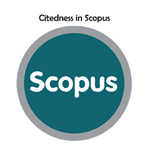Hubungan Kualitas Hidup Dengan Risiko Depresi Pegawai Publik Universitas X Dimasa Pandemi COVID-19
Abstract
Keywords
Full Text:
PDFReferences
V. Vitniawati and A. Jamiyanti, "Status Mental Emosional Karyawan Universitas Bhakti Kencana Saat Menjalani Work From Office (WFO)" Jurnal Psikologi Insight, vol. 5, no. (1), pp. 100-105, 2021.
Kementerian Kesehatan Republik Indonesia, "Pedoman Pencegahan dan Pengendalian Coronavirus Disease (COVID-19)." Kemenkes RI, 2020.
L. Pancani, M. Marinucci, N. Aureli, and P. Riva, "Forced Social Isolation and Mental Health: A Study on 1,006 Italians Under COVID-19 Lockdown" Front. Psychol., vol. 12, pp. 1-10, 2021, doi: 10.3389/fpsyg.2021.663799.
K. T. Ganson, S. D. Weiser, A. C. Tsai, and J. M. Nagata, "Associations between Anxiety and Depression Symptoms and Medical Care Avoidance during COVID-19" J Gen Intern Med, vol. 35, no. 11, pp. 3406-3408, 2020, doi: 10.1007/s11606-020-06156-8.
S. Winurini, "Permasalahan Kesehatan Mental Akibat Pandemi COVID-19" Info Singkat, vol. 12, no. 15, pp. 13-18, 2020.
R. P. Rajkumar, "COVID-19 and mental health: A review of the existing literature" Asian Journal of Psychiatry, vol. 52, pp. 1-5, 2020, doi: 10.1016/j.ajp.2020.102066.
World Health Organization, "Programme On Mental Health: WHOQOL User Manual." Geneva, 2012.
F. D. Algahtani, S.-N. Hassan, B. Alsaif, and R. Zrieq, "Assessment of the Quality of Life during COVID-19 Pandemic: A Cross-Sectional Survey from the Kingdom of Saudi Arabia" IJERPH, vol. 18, no. 3, pp. 1-12, 2021, doi: 10.3390/ijerph18030847.
World Health Organization, "Depression and other common mental disorders: Global health estimates." Geneva, 2017.
C. J. L. Murray, Ed., The Global Burden of Disease: a comprehensive assessment of mortality and disability from diseases, injuries, and risk factors in 1990 and projected to 2020. Cambridge (Massachusetts): Harvard School of Public Health on behalf of the World Health Organization and the World Bank, 1996.
E. Öztürk Çopur and F. Karasu, "The impact of the COVID"19 pandemic on the quality of life and depression, anxiety, and stress levels of individuals above the age of eighteen" Perspect Psychiatr Care, vol. 57, no. 4, pp. 1-11, 2021, doi: 10.1111/ppc.12730.
D. Vibriyanti, "Kesehatan Mental Masyarakat: Mengelola Kecemasan di Tengah Pandemi COVID-19" JKI, pp. 69-74, 2020, doi: 10.14203/jki.v0i0.550.
P. Hyland et al., "Anxiety and depression in the Republic of Ireland during the COVID"19 pandemic" Acta Psychiatr Scand, vol. 142, no. 3, pp. 249-256, 2020, doi: 10.1111/acps.13219.
G. F. Lempang, W. Walenta, K. A. Rahma, N. Retalista, F. J. Maluegha, and F. I. P. Utomo, "Depresi Menghadapi Pandemi Covid-19 pada Masyarakat Perkotaan (Studi Literatur)" pamator, vol. 14, no. 1, pp. 66-71, 2021, doi: 10.21107/pamator.v14i1.9854.
N. Amir, Depresi Aspek Neurobiologi Diagnosis dan Tatalaksana, 2nd ed. Jakarta: Fakultas Kedokteran Universitas Indonesia, 2016.
Y. K. Rohmatin, S. Limantara, and S. Arifin, "Gambaran Kecenderungan Depresi Keluarga Pasien Skizofrenia Berdasarkan Karakteristik Demografi Dan Psikososial" J. Berk. Ked, vol. 12, no. 2, pp. 239-253, 2016, doi: 10.20527/jbk.v12i2.1874.
D. G. Blazer, Mood disorders: epidemiology. Comprehensive textbook of psychiatry, 7th ed. Philadelphia: Lippincott Williams & Wilkins, 2000.
R. C. Kessler, H. Bimbaum, E. Bromet, I. Hwang, N. Sampson, and V. Shahly, "Age differences in major depression: results from the National Comorbidity Survey Replication (NCS-R)" Psychol. Med., vol. 40, no. 2, pp. 225-237, 2010, doi: 10.1017/S0033291709990213.
EuroQol Group, "EQ-5D-5L Crosswalk Index Value Calculator" 2018. https://euroqol.org/wp-content/uploads/2018/02/EQ-5D-5L_Crosswalk_Index_Value_Calculator_v2.xls
M. Reenen, B. Janssen, and E. Stolk, "EQ-5D-5L User Guide: Basic information on how to use the EQ-5D-5L instrument." EuroQol Research Foundation, 2019.
Apriani, H. Lestari, and Harleli, "Gambaran Kualitas Hidup Kesehatan Masyarakat Pada Era Pandemi Covid-19 Di Kota Kendari Tahun 2020" Endemis Journal, vol. 2, no. 1, pp. 19-27, 2021.
P. Chen, L. Mao, G. P. Nassis, P. Harmer, B. E. Ainsworth, and F. Li, "Coronavirus disease (COVID-19): The need to maintain regular physical activity while taking precautions" Journal of Sport and Health Science, vol. 9, no. 2, pp. 103-104, 2020, doi: 10.1016/j.jshs.2020.02.001.
K. Kroenke, R. L. Spitzer, and J. B. W. Williams, "The PHQ-9: Validity of a brief depression severity measure" J Gen Intern Med, vol. 16, no. 9, pp. 606-613, 2001, doi: 10.1046/j.1525-1497.2001.016009606.x.
B. P. Yawn et al., "Concordance of Edinburgh Postnatal Depression Scale (EPDS) and Patient Health Questionnaire (PHQ-9) to Assess Increased Risk of Depression among Postpartum Women" The Journal of the American Board of Family Medicine, vol. 22, no. 5, pp. 483-491, 2009, doi: 10.3122/jabfm.2009.05.080155.
U. Hasanah, N. L. Fitri, Supardi, and Livana, "Depresi Pada Mahasiswa Selama Masa Pandemi Covid-19" JKJ, vol. 8, no. 4, pp. 421-424, 2020, doi: 10.26714/jkj.8.4.2020.421-424.
E. Morgul et al., "COVID-19 pandemic and psychological fatigue in Turkey" Int J Soc Psychiatry, vol. 67, no. 2, pp. 128-135, 2021, doi: 10.1177/0020764020941889.
M. Udedi, A. S. Muula, R. C. Stewart, and B. W. Pence, "The validity of the patient health Questionnaire-9 to screen for depression in patients with type-2 diabetes mellitus in non-communicable diseases clinics in Malawi" BMC Psychiatry, vol. 19, no. 1, pp. 1-7, 2019, doi: 10.1186/s12888-019-2062-2.
N. Fatimah, "Perbedaan antara Obesitas dan Non Obesitas terhadap Kejadian Depresi pada Ibu Rumah Tangga di Daerah Kelurahan Cililitan, Jakarta Timur. Skripsi." Universitas Islam Negeri Syarif Hidayatullah, 2014.
S. B. Tondok, E. Watu, and W. Wahyuni, "Validitas instrumen European Qualitiy of Life (EQ-5D-5L) Versi Indonesia untuk menilai kualitas hidup penderita tuberkulosis" J.HolHealth, vol. 15, no. 2, pp. 267-273, 2021, doi: 10.33024/hjk.v15i2.4759.
B. Darma, Statistika Penelitian Menggunakan SPSS. Jakarta: Guepedia, 2021.
H. Ghodang, Metode Penelitian Kuantitatif Konsep Dasar & Aplikasi Analisis Regresi dan Jalur dengan SPSS. Medan: Mitra Grup, 2020.
Nurhasanah, H. Kushadiwijaya, and C. Marchira, "Hubungan Tingkat Depresi dengan Kualitas Hidup Pada Daerah Bencana Pasca Gempa Bumi di Kabupaten Sleman Tahun 2008" Berita Kedokteran Masyarakat, vol. 25, no. 1, pp. 1-8, 2009.
E. E. Michalak, L. N. Yatham, and R. W. Lam, "Quality of life in bipolar disorder: A review of the literature" Health Qual Life Outcomes, vol. 3, no. 72, pp. 1-17, 2005, doi: 10.1186/1477-7525-3-72.
DOI: https://doi.org/10.37311/ijpe.v3i1.18836
Refbacks
- There are currently no refbacks.
Copyright (c) 2023 Shoma Rizkifani, Nia Resseda

Indonesian Journal of Pharmaceutical Education is licensed under a Creative Commons Attribution-NonCommercial-ShareAlike 4.0 International License.




